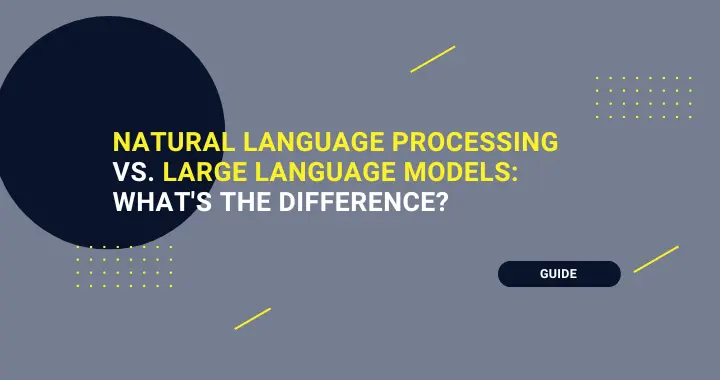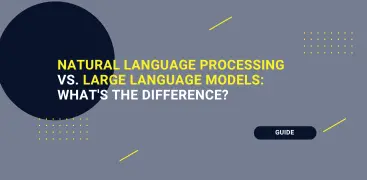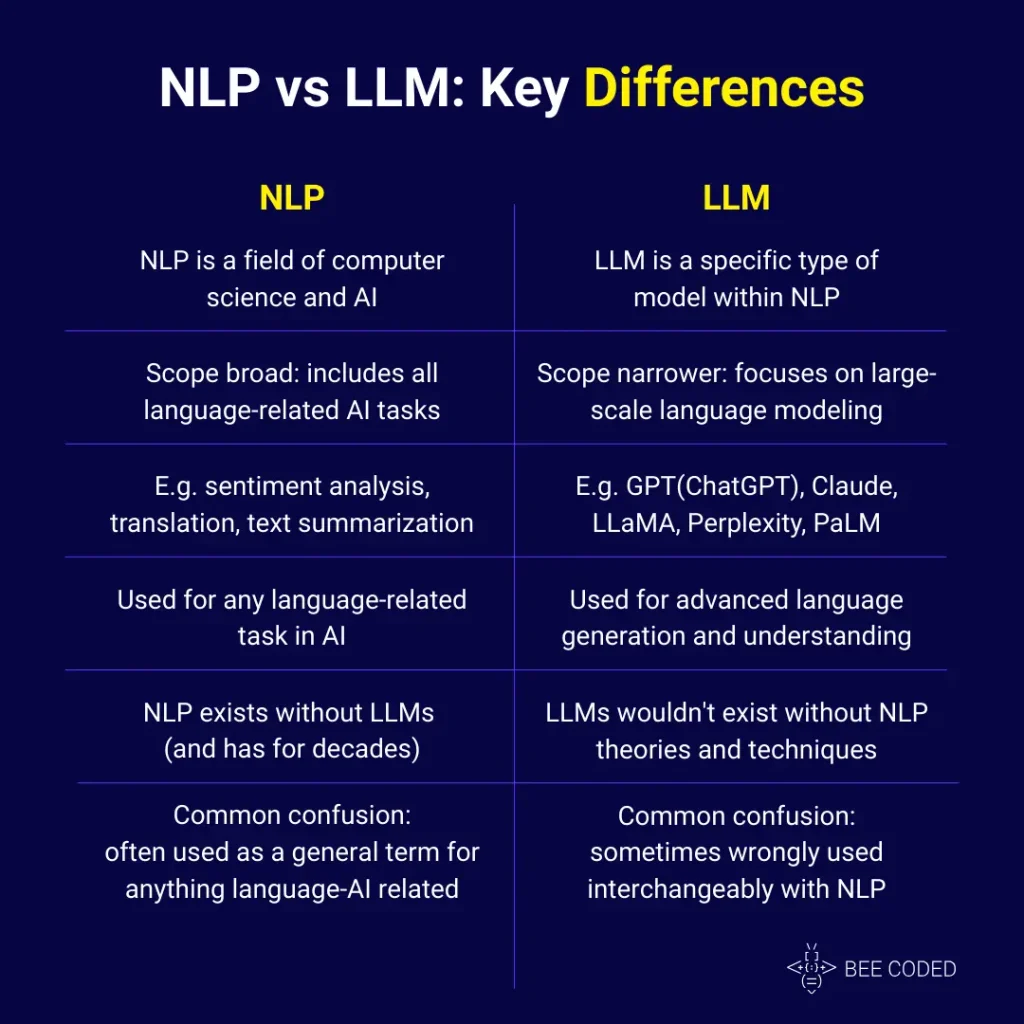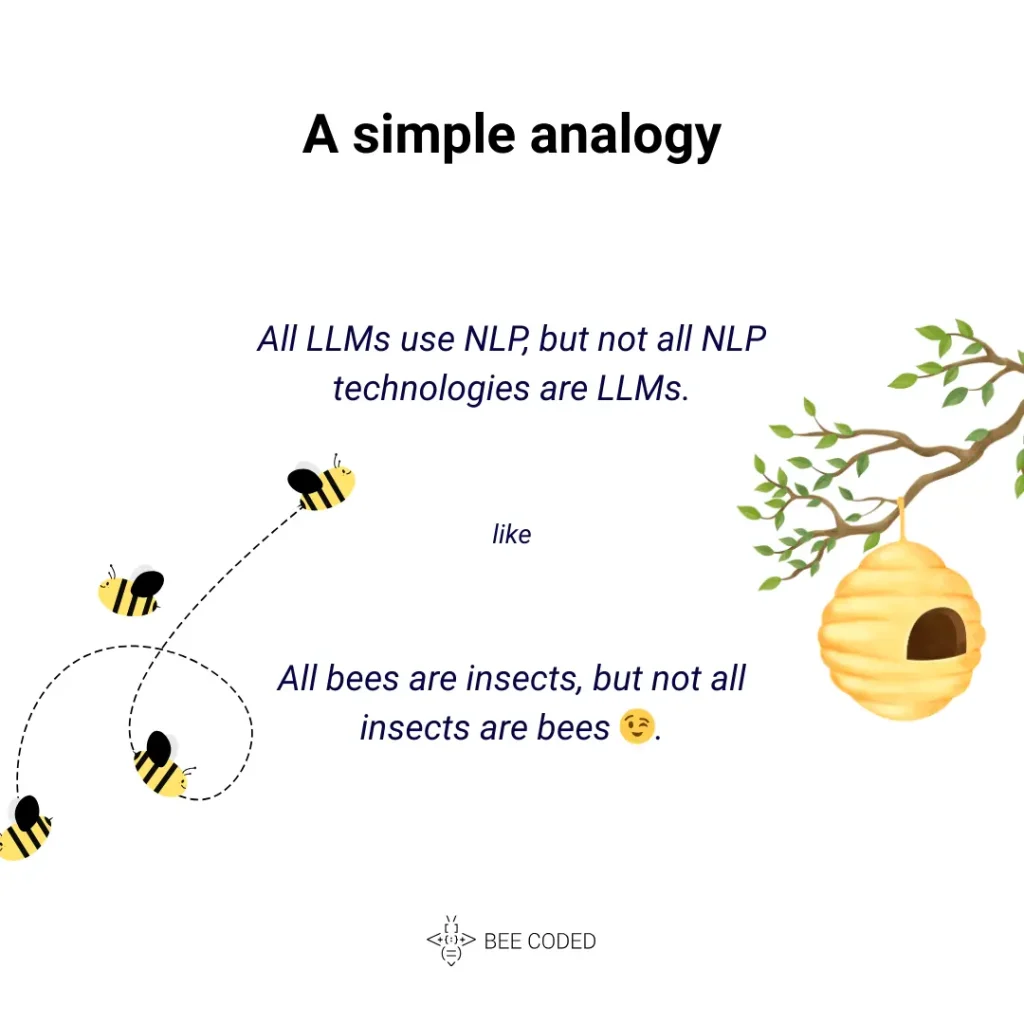- Industry insights
- People in tech
- Tech trends at BEECODED
- 30 Apr 2025
Natural Language Processing (NLP) vs. Large Language Models (LLM): What’s the Difference?
Because both are related to language, the two can be confused. We aim to shed some light on the differences between NLP (the underlying technology) and LLM (a tool built using that technology).



Table of contents
Contributors

NLP vs LLM: there are two acronyms that are increasingly common in the field of artificial intelligence: NLP (natural language processing) and LLM (large language models). Because both are related to language, the two can be confused. In this article, we aim to shed some light on the differences between NLP (the underlying technology) and LLM (a tool built using that technology).
If you’d like a better understanding of what NLP is, we recommend reading this article first, then coming back here.
What is Natural Language Processing (NLP)?
NLP – or natural language processing – is a branch of artificial intelligence that deals with the understanding and interpretation of human language by computers. In other words, it’s the technology that makes it possible for a program to understand what people are saying. And chances are, you’ve already used NLP-based tools like Siri or Google Translate.
Before we go any further, it’s important to note that NLP is the core technology. LLMs, which we’ll discuss in the next section, are built on top of it.
What is a Large Language Model (LLM)?
An LLM (large language model) is an advanced type of artificial intelligence model that uses NLP techniques, but on a much larger scale. It’s trained on massive amounts of text and learns to generate, summarize, translate, or interpret content, mimicking the way we think and communicate. The most well-known example is ChatGPT, but there are others too, like Claude, PaLM, or Perplexity.
NLP vs LLM: Key Differences
To make it easier for you to see the differences, we’ve created a table comparing them:

Are NLP and LLM the Same?
Although they are related, they are not synonymous. An LLM is an advanced application of NLP.
NLP, on the other hand, includes many other techniques and methods that don’t necessarily involve LLM-style models.

How Do LLMs Use NLP Techniques?
Even if LLMs, like ChatGPT, seem to understand everything you tell them, the truth is that there are a lot of NLP-specific tasks running in the background, such as:
Named Entity Recognition (NER)
NER is a technique by which the model identifies important entities in a text, such as people’s names, places, calendar dates, etc. By understanding these details, the system will know how to respond correctly and contextually.
For example, if we say, “In March 2025, Alice Smith visited Paris,” and then ask, “Which city did Alice visit?” — The model will understand that the correct answer is Paris.
Sentiment Analysis
This is the model’s ability to detect the emotional tone in a text. It helps to determine whether what you’re saying is positive, negative, or neutral. When the system understands the emotion behind the words, it can respond in a more human-like way. If you’re upset, it will respond with empathy. If you’re happy, it will respond with joy, etc.
POS Tagging (Part-of-Speech Tagging)
POS tagging is the process by which each word in a sentence is identified as a noun, verb, adjective, adverb, etc. In this way, the system will better understand what you’re saying, and it will maintain correct grammar when generating new sentences.
See more techniques in our article here.
Use Cases: When to Use NLP vs LLM
The choice between the two depends on the complexity of the task you want to accomplish and the type of result you want.
- When to use NLP?
NLP is suitable for simpler tasks where you want a system to perform specific actions with human text or language:
- Identifying keywords in a text (e.g., using NER to identify names or locations).
- Automatically translating between languages (e.g., Google Translate).
- Correcting grammar or performing syntactic analysis of a text.
- When to use LLM?
An LLM (large language model), on the other hand, is much more powerful and complex. If you need a system that can understand human language more deeply, choose an LLM, because it can:
- Generate texts that sound natural and coherent, ranging from full articles to detailed answers to complex questions (as seen with ChatGPT).
- Understand and answer open-ended questions (e.g., if you ask an LLM about a broad topic, it can provide complex answers).
- Create natural, long-term conversations.
- Generate code for specific programming tasks.
Are you looking to build an AI-powered application?
We can help!
Whether you want a chatbot, a smart assistant, or intelligent content generation tools, Bee Coded team can help you leverage both NLP and LLM to build cutting-edge software.
What is text analytics in AI?
10 NLP examples you use every day without realizing
12 Natural Language Processing techniques used to process text by data scientists